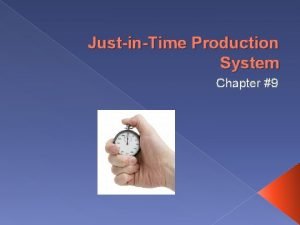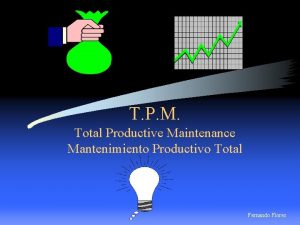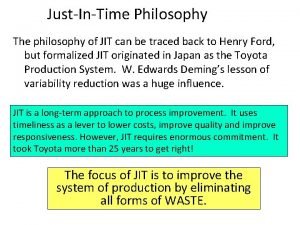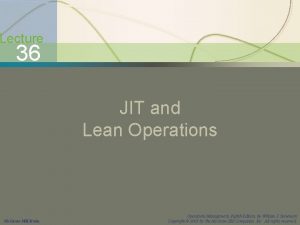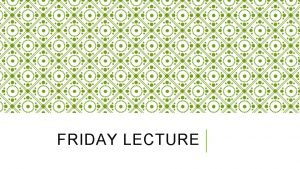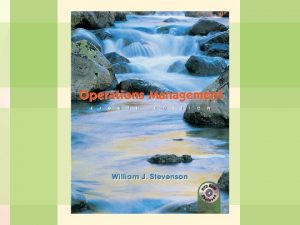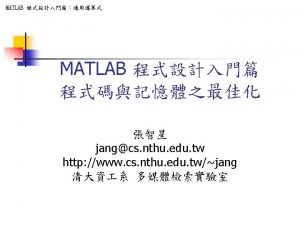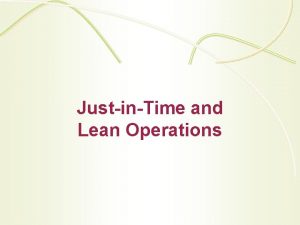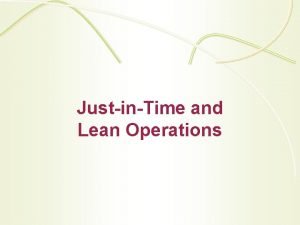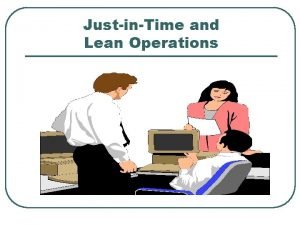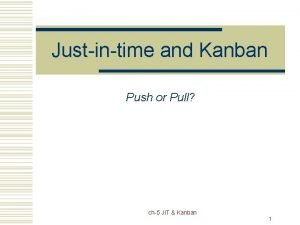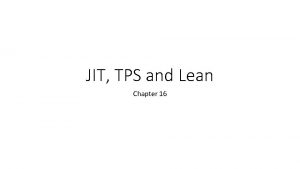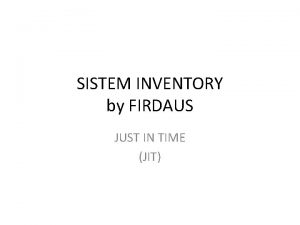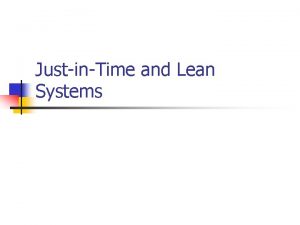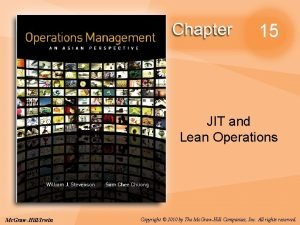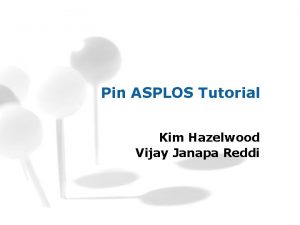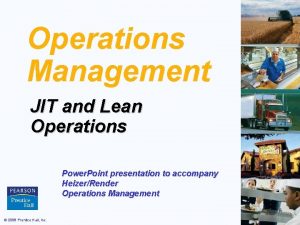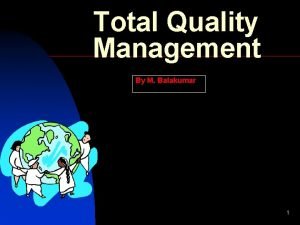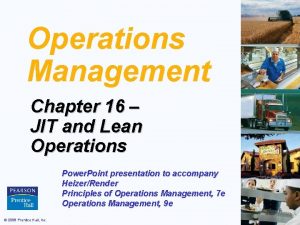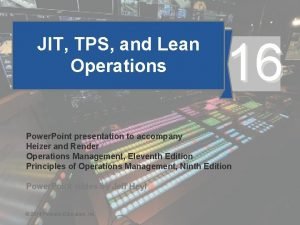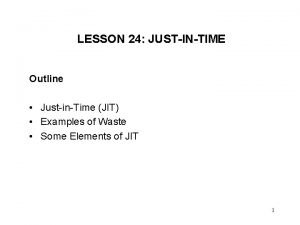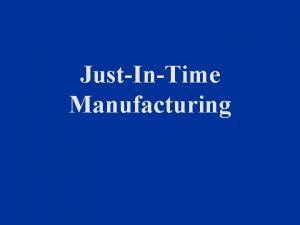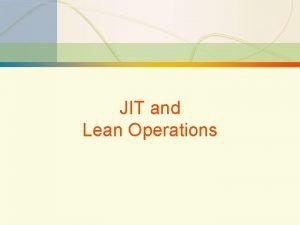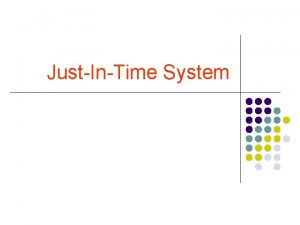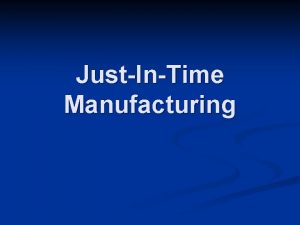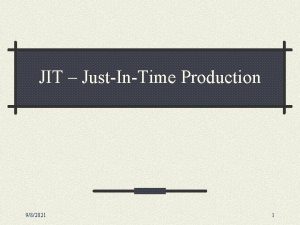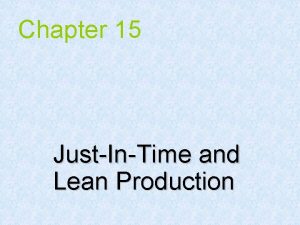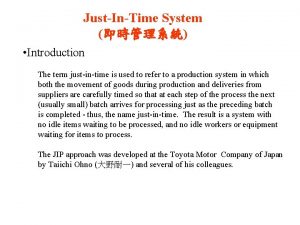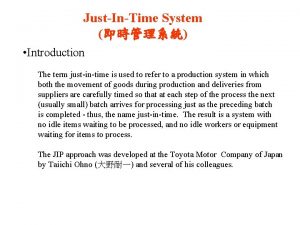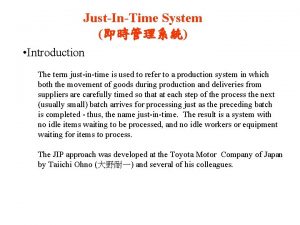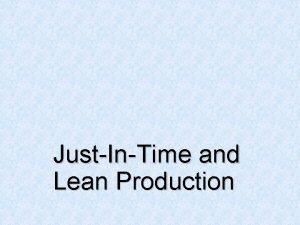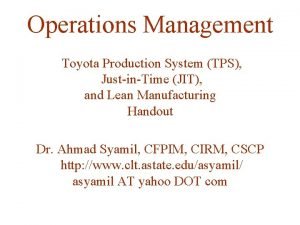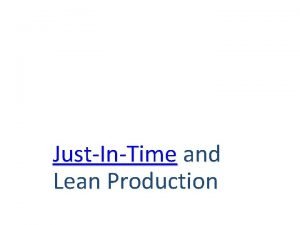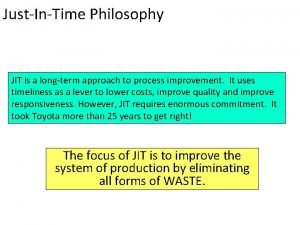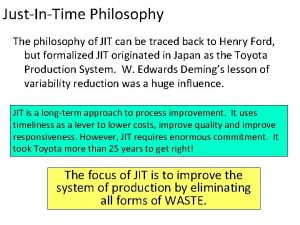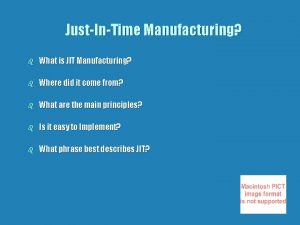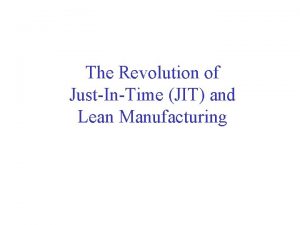JustInTime Chapter 3 JIT Overview l JIT is












![Calculating Number of Kanbans l l l Y=no. of kanbans D=demand/unit of time [800/day] Calculating Number of Kanbans l l l Y=no. of kanbans D=demand/unit of time [800/day]](https://slidetodoc.com/presentation_image/53b64964a2b762087e448a04eefaf8a7/image-13.jpg)
















- Slides: 29

Just-In-Time Chapter 3

JIT Overview l JIT is both a management philosophy and a set of operational techniques. • An element of the Toyota’s Production System (VBW, Figure 3. 17) l The philosophy is based on: • Planned elimination of all waste • Continuous improvement of productivity

Sources of Waste l Overproduction (inventory) l Defects l Personnel l Equipment l Space l Time (inefficiency) l Utilities

Major Elements of JIT l Carry inventory only when needed l Improve quality to zero defects l Reduce setup times and lot sizes. l Focus on continual improvement. l Make efforts to involve workers and use their knowledge to a greater extent. l Achieve improvement at minimum cost

JIT in Manufacturing l JIT makes major changes in the actual practice of manufacturing by reducing: • Complexity of detailed material planning. • Need for shop-floor tracking. • Work-in-process inventories. • Transactions associated with shop-floor and purchasing systems.

JIT in Services l Synchronize and balance information and workflow l Increase process visibility l Continuously improve processes l Eliminate all waste (including paperwork) l Increase resource flexibility

JIT and MPC: the System (VBW, figure 3. 1)

JIT and MPC l Front end: l Engine: l Back end: • Level capacity loading • Reduce number of part numbers planned. • Reduce number of levels in the BOM. • Focus on simplicity—shop-floor and purchasing. • Backflushing.

JIT and MPC Building Blocks (Table 3. 1, VBW, p. 77) l Product design • Standard parts, product simplification, modular design, robust design, scheduled design changes, design quality l Process design • Band width—surge capacity to accommodate product mix and demand variations. Process flexibility • • Setup time reduction • Cellular system

JIT and MPC Building Blocks (Table 3. 1, VBW, p. 77) l Human/organizational elements • Whole person concept—continual learning and • • l improvement. Cross-training Motivation and empowerment Manufacturing planning/control • Pull system • Visibility • Simplified planning and control

JIT Example—Muth Pots l l Leveling the production Pull system introduction • Material movements and production authorized by • • l l l signal of need from a “downstream” work center. Schedule must be “frozen” for a period of time. Determine the container size/capacity/number. Product design Process design Bill of materials implications

JIT Applications l Single-card kanban system (Figure 3. 16, p. 90) l Two-card kanban system (Toyota) • Transport, or conveyance, card. • Production card. l Two-bin or three-bin system l Kanban cards replace all work orders and move tickets. l Kanban cards may be used with suppliers.
![Calculating Number of Kanbans l l l Yno of kanbans Ddemandunit of time 800day Calculating Number of Kanbans l l l Y=no. of kanbans D=demand/unit of time [800/day]](https://slidetodoc.com/presentation_image/53b64964a2b762087e448a04eefaf8a7/image-13.jpg)
Calculating Number of Kanbans l l l Y=no. of kanbans D=demand/unit of time [800/day] L=lead time [2 hours=0. 25 days] a=container capacity [20] =safety stock [25%]

Control Through Signaling l Simplicity l Use different methods – kanban, container, tennis balls, computerized display board (Andon board), etc. l Planning to schedule/producing to pull signal • Make or move only with an authorized signal • First-in, first-out

Workplace Organization l Is referred to as housekeeping l Is a means to identify and maintain an orderly environment l Is a prerequisite for inventory management l Prevents errors and contamination l Basic concepts: simplification, organization, discipline, cleanliness, participation

Six (6) S’s l Seiri – organization l Seiton –tidiness l Seiso –purity l Seiketsu – cleanliness l Shitsuke – discipline l Shikkari-yarou – let’s try hard

Setup Time l Internal versus external setup time (setup time when the machine is not running) l Reduce the setup time by studying: • The machine itself • Attachments • Tools • Workplace organization • Transfer of internal setup to external setup

Maintenance l l l Focus on preventive maintenance Develop a total productive maintenance system (TPM) Train and assign workers to carry out preventive maintenance on their machines Provide technical assistance for workers Develop a set of measurements for improving the maintenance system

Flexibility l Mobility l Variable output rate l Multipurpose l Flexible capability l Simplicity l Surge capacity

Transportation Strategies l Repetitive schedules l Mixed loads l Milk run l Freight consolidation l Local warehouses l Local suppliers

Implication of JIT in Repetitive Systems l Use production rates instead of work orders l Gross-only explosions for MRP l No lead-time offset is required l Cumulative MRP format may be used l No need for due dates on individual lots l Planning buckets are usually in days or weeks

Implications of JIT in Job Shop l Visual control of queues l The level of BOM is reduced l Manage the total load of the shop l Use rate-based scheduling l Use mixed-model scheduling l Use cellular layout l Emphasis part standardization

JIT in Purchasing l Basics: • Scheduling system producing reasonably certain • • l requirements. Achieving a stable schedule. Pursuing all JIT objectives and building blocks. Pruning the number of vendors. Controlling the cost of transportation. Lessons • Don’t shift inventory-holding from the company to the • vendor. Effectively manage vendor relationships.

Implication of JIT in Human Resources Management l Employee involvement and empowerment l Motivation l Suggestion systems l Intra- and inter-functional teams l Job design l Compensation and rewards l Education and training l Relationships with unions

Changing Roles and Responsibilities - Management l Culture change – from maintain status quo to improvement l Supervisors as coaches l Treat employees fairly l Sharing information l Provide support and motivation l Provide extra time for improvement

Changing Roles and Responsibilities - Employees l Make decisions and solve problems l Help make improvement l Work with colleagues closely l Expanded job responsibilities l Responsibility at the source l Use scientific techniques

Concluding Principles l l Stabilizing and in some cases leveling the production schedules are prerequisites to effective JIT systems. Achieving very short lead times supports better customer service and responsiveness. Reducing hidden factory costs can be at least as important as reducing costs more usually attributed to factory operations. Implementing the whole person concept reduces distinctions between white- and blue-collar workers and taps all persons’ skills for improving performance.

Concluding Principles l l l Cost accounting and performance measurements need to reflect the shift in emphasis away from direct labor as the primary source of value added. To achieve JIT’s benefits in nonrepetitive applications, some basic features of repetitivebased JIT must be modified. JIT is not incompatible with MRP-based systems. Firms can evolve toward JIT from MRP-based systems, adopting JIT as much as or little as they want, with an incremental approach.

Homework Assignment l Problem 3. 2 and 3. 12 l Due Tuesday, December 3
 Justintime production
Justintime production Warp jit service
Warp jit service Estructura organizacional tpm
Estructura organizacional tpm Just-in-time philosophy
Just-in-time philosophy Jit and lean operations
Jit and lean operations Jit approach
Jit approach Jit philosophy
Jit philosophy Lean operations management
Lean operations management Vectorizing matlab
Vectorizing matlab Characteristics of just-in-time partnerships do not include
Characteristics of just-in-time partnerships do not include Formula kanban
Formula kanban What is jit
What is jit Kanban push pull
Kanban push pull Jit layout tactics
Jit layout tactics Jit and tqm
Jit and tqm Just intime
Just intime Kelemahan jit
Kelemahan jit Philosophy of jit
Philosophy of jit Jit building blocks
Jit building blocks Kim hazelwood
Kim hazelwood Toyota production system lean manufacturing ppt
Toyota production system lean manufacturing ppt Lean building blocks
Lean building blocks Jit balakumar
Jit balakumar Jit scheduling tactics
Jit scheduling tactics Jit tps and lean operations
Jit tps and lean operations Jit layout tactics
Jit layout tactics Kanban squares
Kanban squares What is jit
What is jit Jit inventory
Jit inventory Chapter 24 trauma overview
Chapter 24 trauma overview
